Surface Wettability and Electrical Resistance Analysis of Droplets on Indium-Tin-Oxide Glass Fabricated Using an Ultraviolet Laser System
Abstract
1. Introduction
2. Fundamental Theory
3. Materials and Experimental Setup
3.1. Materials
3.2. Experimental Setup
3.2.1. Pattern Fabrication: UV Laser (Wavelength- 355 nm) Processing
3.2.2. Surface Morphology Observation and CA Measurement
3.2.3. Experimental Process
- Step (I):
- AutoCAD (2017, Autodesk, San Rafael, CA, USA) was used to design the writing path of the laser spot. The left line and ablated line width of the ITO film were the same dimension, either 70, 90, 110, or 130 μm.
- Step (II):
- The parameters, such as the power and pulse repetition frequency of the laser system, were fixed, and the scanning speed and repetition times were adjusted to generate the comb-pattern microstructures with varying surface roughness and depth.
- Step (III):
- A 3D confocal microscope was used to measure the edge contour, line depth, and the morphology of the microstructures, and we analyzed the relationship of the depth and surface roughness of the ablated lines with the various repetition times and scanning speeds during laser treatment. The surface roughness is reported as mean height (Sa) and root mean square height (Sq). The Sa and Sq were defined by the average value and root mean square along the sampling area, respectively. In addition, the roughness of ablated line was also measured and defined as Ra (mean height) and Rq (root mean square).
- Step (IV):
- A digital microscope was set up to acquire a cross-section image of the droplet. Before acquiring the droplet image, we used the block gauge with an angle of 30°, 60°, and 90° to acquire the image and analyze the angle for the calibration process (Figure 5).
- Step (V):
- After the calibration, we placed the ITO glass on the stage in front of the digital microscope and added a droplet of deionized water on the microstructure region of the ITO glass surface. Each experimental parameter was repeated three times, and the volume of the droplet was determined in the first experiment. In addition, an electrical charge was exerted on the pad to observe the deformation of the droplet and investigate the variation in the CA. The relationship between the CA, surface roughness, ablated line pitch, and depth of the ITO film was analyzed to obtain the optimal parameters of the microstructure for enhancing the CA and generating a spherical droplet for biochip application.
4. Experimental Results and Discussion
4.1. Effect of Droplet Volume on CA
4.2. Effect of Scanning Speed on CA and Line Roughness
4.3. Effect of Line Pitch and Laser Scanning Speed on CA
4.4. Effect of Repetition Times on CA
4.5. Effect of Electric Field on CA
5. Conclusions
Author Contributions
Funding
Data Availability Statement
Conflicts of Interest
References
- Dalili, A.; Samiei, E.; Hoorfar, M. A review of sorting, separation and isolation of cells and microbeads for biomedical applications: Microfluidic approaches. Analyst 2019, 144, 87–113. [Google Scholar] [CrossRef]
- Tang, W.; Jiang, D.; Li, Z.; Zhu, L.; Shi, J.; Yang, J.; Xiang, N. Recent advances in microfluidic cell sorting techniques based on both physical and biochemical principles. Electrophoresis 2019, 40, 930–954. [Google Scholar] [CrossRef]
- Volpe, A.; Gaudiuso, C.; Ancona, A. Sorting of Particles Using Inertial Focusing and Laminar Vortex Technology: A Review. Micromachines 2019, 10, 594. [Google Scholar] [CrossRef]
- Kim, P.; Kwon, K.W.; Park, M.C.; Lee, S.H.; Kim, S.M.; Suh, K.Y. Soft Lithography for Microfluidics: A Review. Biochip J. 2008, 2, 1–11. [Google Scholar]
- Liao, Y.; Song, J.; Li, E.; Luo, Y.; Shen, Y.; Chen, D.; Cheng, Y.; Xu, Z.; Sugioka, K.; Midorikawa, K. Rapid prototyping of three-dimensional microfluidic mixers in glass by femtosecond laser direct writing. Lab Chip 2012, 12, 746–749. [Google Scholar] [CrossRef]
- Volpe, A.; Krishnan, U.; Chiriacò, M.S.; Primiceri, E.; Ancona, A. A smart procedure for the femtosecond laser-based fabrication of a polymeric lab-on-a-chip for capturing tumor cell. Engineering 2020. [Google Scholar] [CrossRef]
- Xu, B.B.; Zhang, Y.L.; Xia, H.; Dong, W.F.; Ding, H.; Sun, H.B. Fabrication and multifunction integration of microfluidic chips by femtosecond laser direct writing. Lab Chip 2013, 13, 1677–1690. [Google Scholar] [CrossRef]
- Azmayesh-Frad, S.M.; Flaim, E.; McMullin, J.N. PDMS biochip with integrated waveguides. J. Micromech. Microeng. 2010, 20, 1–5. [Google Scholar] [CrossRef]
- Zhang, L.; Wang, W.; Ju, X.J.; Xie, R.; Liu, Z.; Chu, L.Y. Fabrication of glass-blasédmicrofluidic devices with dry film photoresists as pattern transfer masks for wet etching. RSC Adv. 2015, 5, 5638–5646. [Google Scholar] [CrossRef]
- Wang, T.; Chen, J.; Zhou, T.; Song, L. Fabricating Microstructures on Glass for Microfluidic chip by Glass Molding Process. Micromachines 2018, 9, 269. [Google Scholar] [CrossRef] [PubMed]
- García, D.N.; O’Connor, G.M. Laser-Based Fabrication for Microfluidic Devices on Glass for Medical Applications. In Advances in Microfluidics-New Applications in Biology, Energy, and Materials Sciences; IntechOpen Limited: London, UK, 2016. [Google Scholar] [CrossRef]
- Joung, S.R.; Kim, J.; Choi, Y.J.; Kang, C.J.; Kim, Y.S. ITO-Coated glass/polydimethylsiloxane continuous-flow PCR chip. IEEE Int. Conf. Nano/Micro Eng. Mol. Syst. 2007, 691–694. [Google Scholar] [CrossRef]
- Wu, H.W.; Huang, Y.S.; Lee, H.Y.; Tsai, W.H. High efficiency light-induced dielectriphoresis biochip prepared using CVD techniques. Biomed. Microdevices 2016, 18, 79. [Google Scholar] [CrossRef] [PubMed]
- Ghrera, A.S.; Pandey, C.M.; Ali, M.A.; Malhotra, B.D. Quantum dot-based microfluidic biosensor for cancer detection. Appl. Phys. Lett. 2015, 106, 193703. [Google Scholar] [CrossRef]
- Konry, T.; Hadad, B.; Shemer-Avni, Y.; Cosnier, S.; Marks, R.S. ITO pattern fabrication of glass platforms for electropolymerization of light sensitive polymer for its conjugation to bioreceptors on a micro-array. Talanta 2008, 75, 564–571. [Google Scholar] [CrossRef] [PubMed]
- Huang, H.Y.; Kao, W.L.; Wang, Y.W.; Yao, D.J. Using a diaelectrophoretic microfluidic biochip enhanced fertilization of mouse embryo in Vitro. Micromachines 2020, 11, 714. [Google Scholar] [CrossRef]
- Samuel, B.; Zhao, H.; Law, K.Y. Study of Wetting and Adhesion Interactions between Water and Various Polymer and Superhydrophobic Surfaces. J. Phys. Chem. C 2011, 115, 14852–14861. [Google Scholar] [CrossRef]
- Vrakatseli, V.; Farsari, E.; Mataras, D. Wetting properties of transparent anatase/rutile mixed phase glancing angle magnetron sputtered nano-TiO2 films. Micromachines 2020, 11, 616. [Google Scholar] [CrossRef]
- Law, K.Y. Definitions for Hydrophilicity, Hydrophobicity, and Superhydrophobicity: Getting the Basics Right. J. Phys. Chem. Lett. 2014, 5, 686–688. [Google Scholar] [CrossRef]
- Xu, Q.; Zhang, W.; Dong, C.; Sreeprasad, T.S.; Xia, Z. Biomimetic self-cleaning surface: Synthesis, mechanism and applications. J. R. Soc. Interface 2016, 13, 20160300. [Google Scholar] [CrossRef]
- Lin, X.; Yang, M.; Jeong, H.; Chang, M.; Hong, J. Durable superhydrophilic coatings formed for anti-biofouling and oil-water separation. J. Membr. Sci. 2016, 506, 22–30. [Google Scholar] [CrossRef]
- Zhu, L.; Feng, Y.; Ye, X.; Zhou, Z. Tuning wettability and getting superhydrophobic surface by controlling surface roughness with well-designed microstructures. Sens. Actuators A 2006, 130–131, 595–600. [Google Scholar] [CrossRef]
- Jung, Y.C.; Bhushan, B. Contact angle, adhesion and friction properties of micro- and nanopatterned polymers for superhydrophobicity. Nanotechnology 2006, 17, 4970–4980. [Google Scholar] [CrossRef]
- Toosi, S.F.; Moradi, S.; Hatzikiriakos, S.G. Fabrication of micro/nano pattern on polymeric substrates using laser ablation methods to control wettability behaviour: A critical review. Rev. Adhes. Adhes. 2017, 5, 55–78. [Google Scholar] [CrossRef]
- Ryu, H.S.; Kim, H.S.; Kim, D.; Lee, S.J.; Choi, W.; Kwon, S.J.; Han, J.H.; Cho, E.S. Understanding of the mechanism for laser ablation-assisted patterning of graphene/ITO double layers: Role of effective thermal energy transfer. Micromachines 2020, 11, 821. [Google Scholar] [CrossRef] [PubMed]
- Tsai, H.Y.; Hsieh, Y.C.; Lin, Y.H.; Chang, H.C.; Tang, Y.H.; Huang, K.C. Fabrication of hydrophilic surface on rigid gas permeable contact lenses to enhance the wettability using ultraviolet laser system. Micromachines 2019, 10, 394. [Google Scholar] [CrossRef] [PubMed]
- Schrader, M.E.; Loeb, G.I. Modern Approaches to Wettability, Theory and Applications; Plenum Press: New York, NY, USA, 1992; ISBN 978-0-306-43985-8. [Google Scholar]
- Hebbar, R.S.; Isloor, A.M.; Ismail, A.F. Chapter 12-contact angle measurement. In Membrane Characterization; Elsevier: Amsterdam, The Netherlands, 2017; pp. 219–255. [Google Scholar]
- Young, T. An Essay on the Cohesion of Fluids. Philos. Trans. R. Soc. Lond. 1805, 95, 65–87. [Google Scholar]
- Whyman, G.; Bormashenko, E.; Stein, T. The rigorous derivation of Young, Cassie–Baxter and Wenzel equations and the analysis of the contact angle hysteresis phenomenon. Chem. Phys. Lett. 2008, 450, 355–359. [Google Scholar] [CrossRef]
- Ishino, C.; Okumura, K. Wetting transitions on textured hydrophilic surfaces. Eur. Phys. J. E 2008, 25, 415–424. [Google Scholar] [CrossRef]
- Kim, D.; Pugno, N.M.; Ryu, S. Wetting theory for small droplet on textured solid surfaces. Sci. Rep. 2016, 6, 37813. [Google Scholar] [CrossRef]
- Zhang, B.X.; Wang, S.L.; Wang, X.D. Wetting transition from the Cassie-Baxter state to the Wenzel state on regularly nanostructured surfaces induced by an electric field. Langmuir 2019, 35, 662–670. [Google Scholar] [CrossRef]
- Ren, B.Y.; Liu, X.P.; Wang, M.H.; Xu, Y. Preparation and characteristics of indium tin oxide (ITO) thin films at low temperature by r.f. magnetron sputtering. Rare Met. 2006, 25, 137–140. [Google Scholar] [CrossRef]

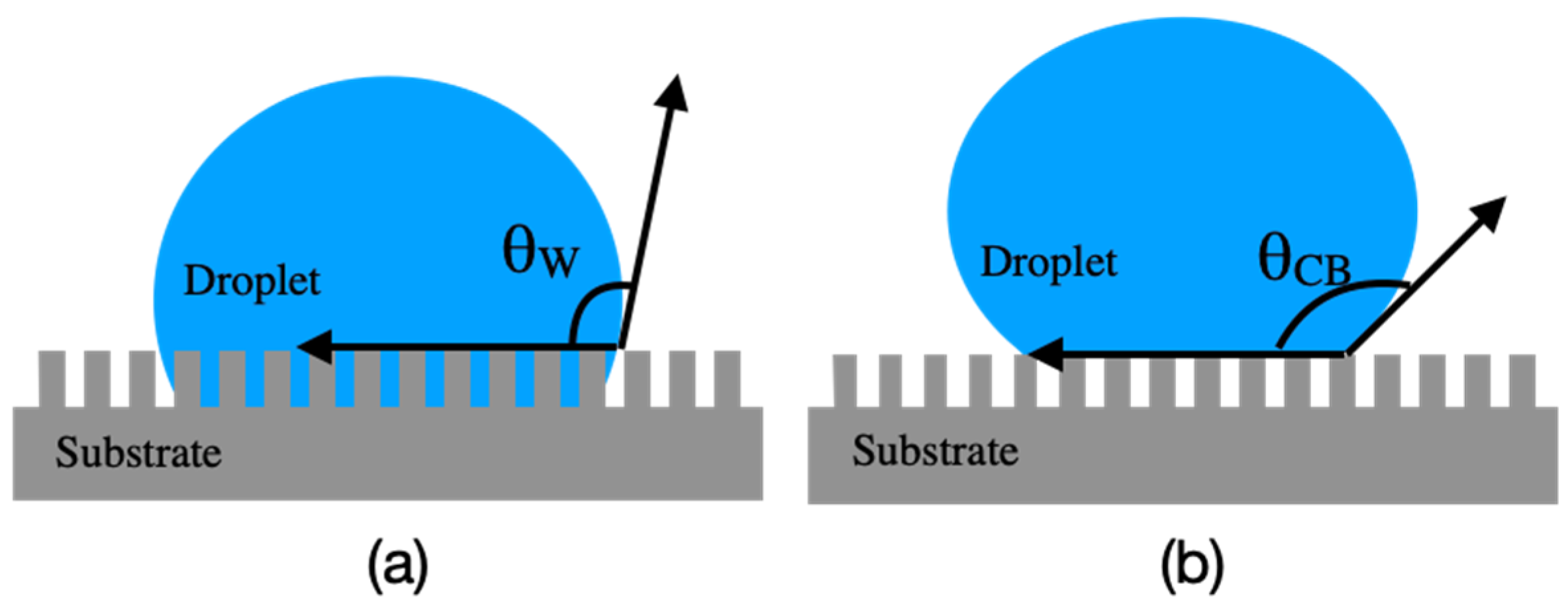

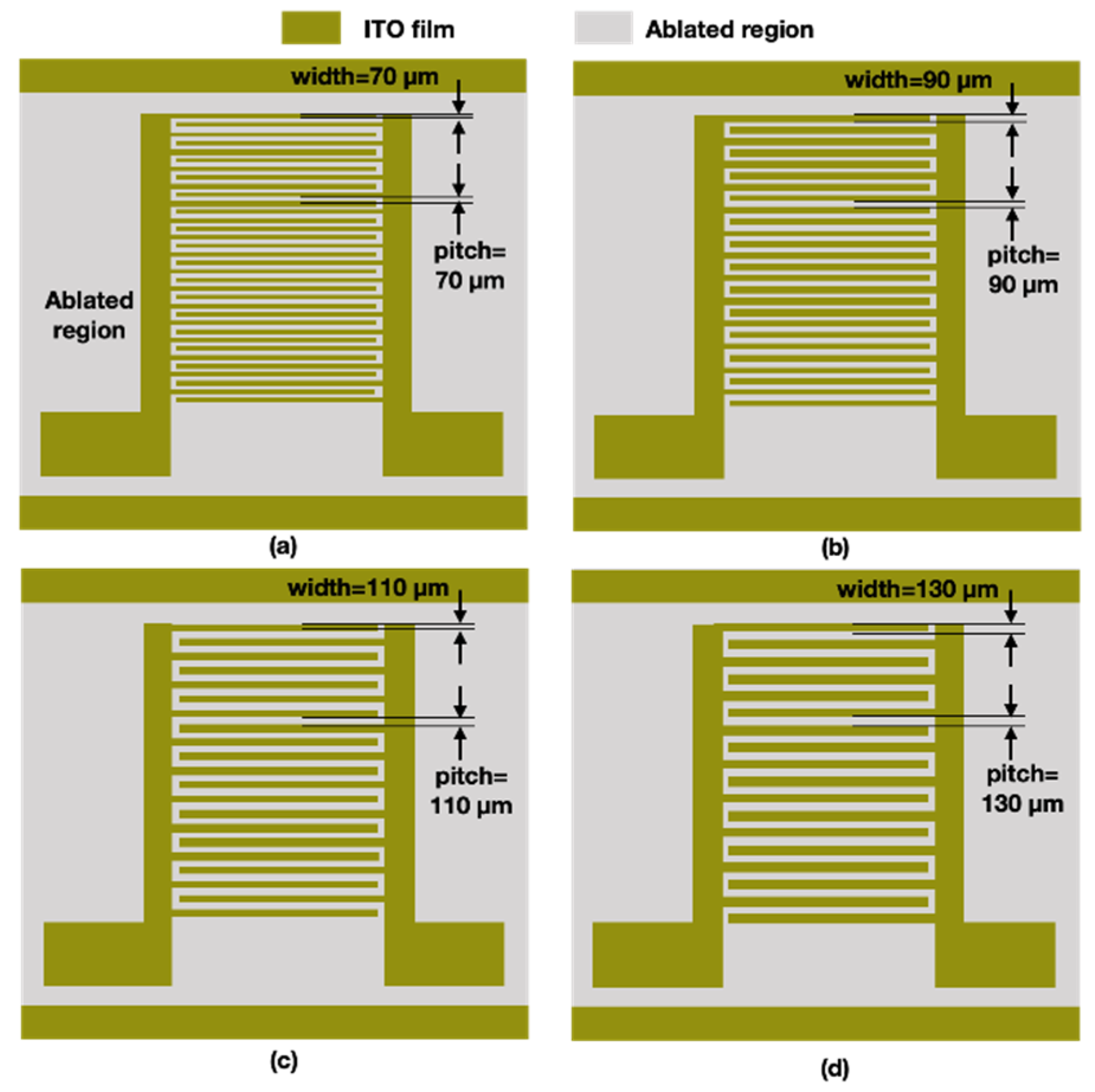
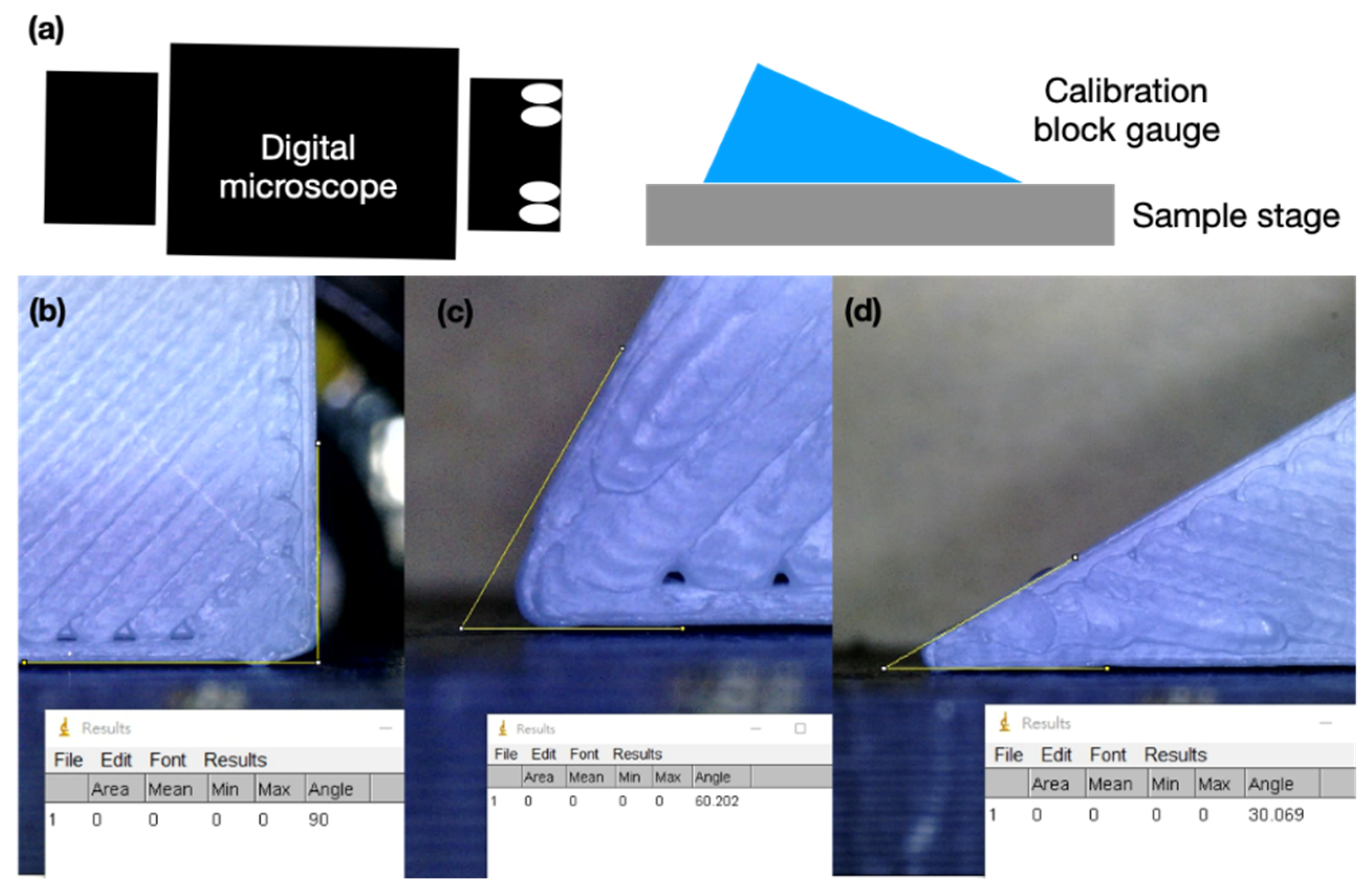
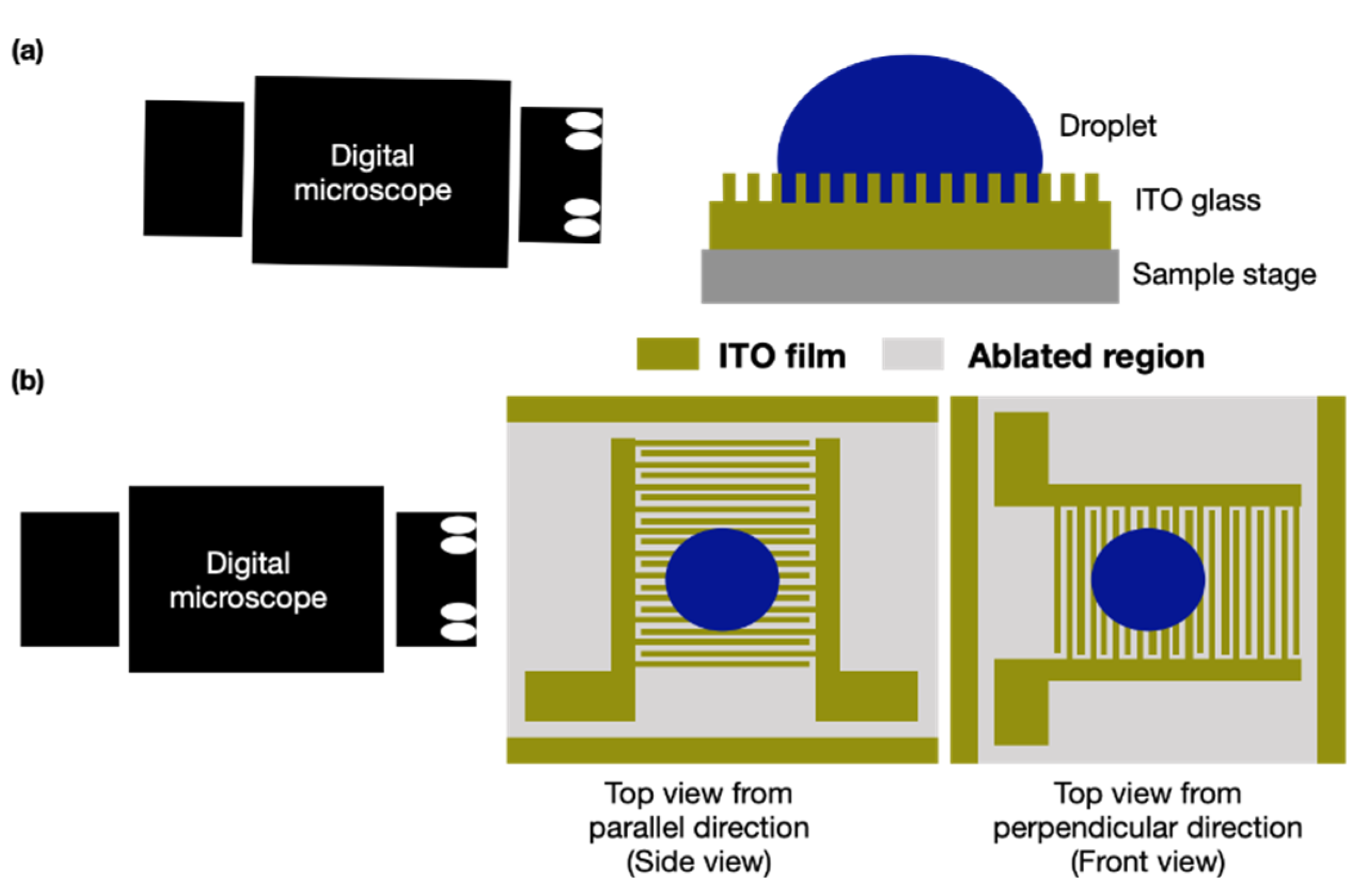
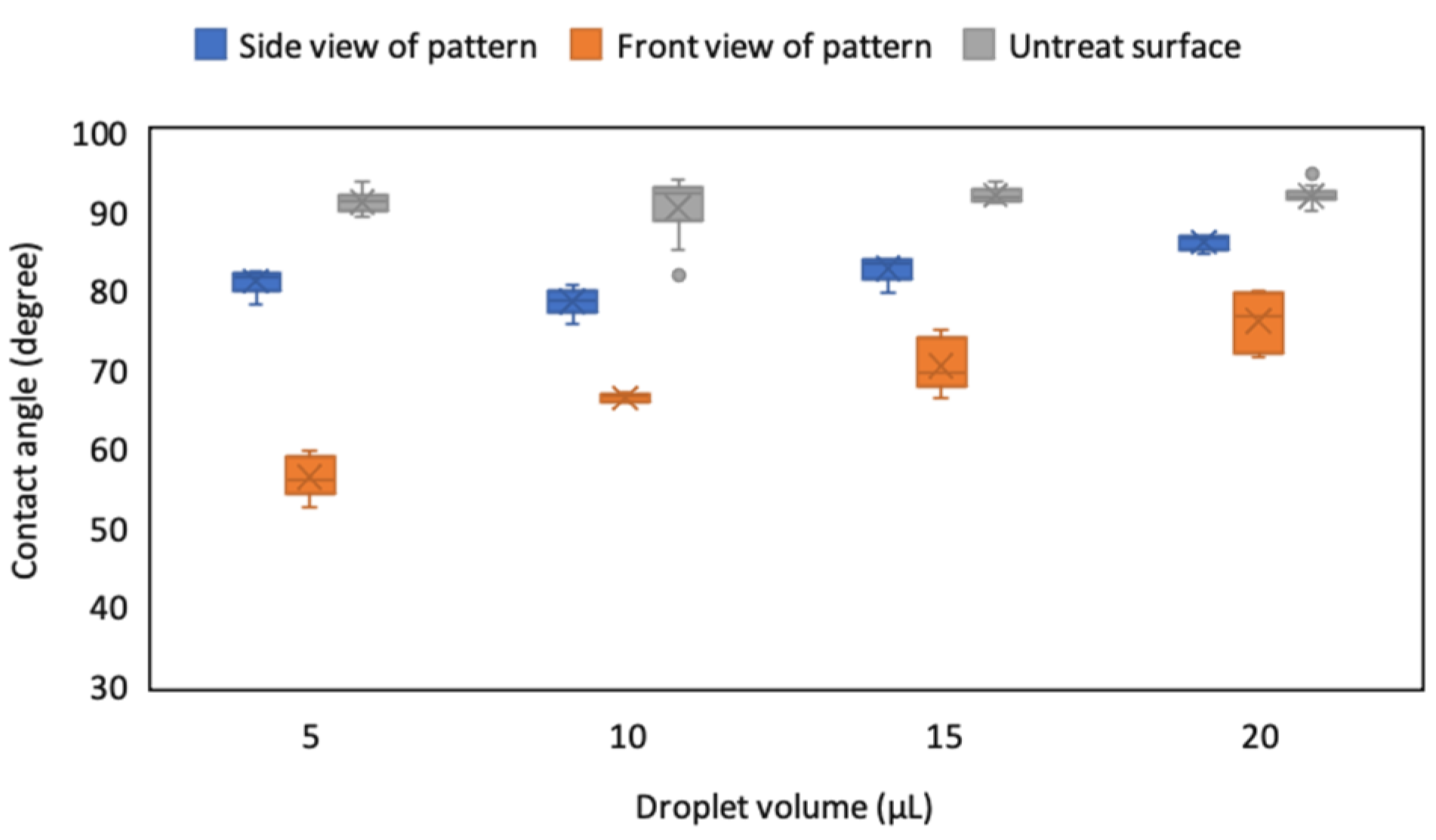
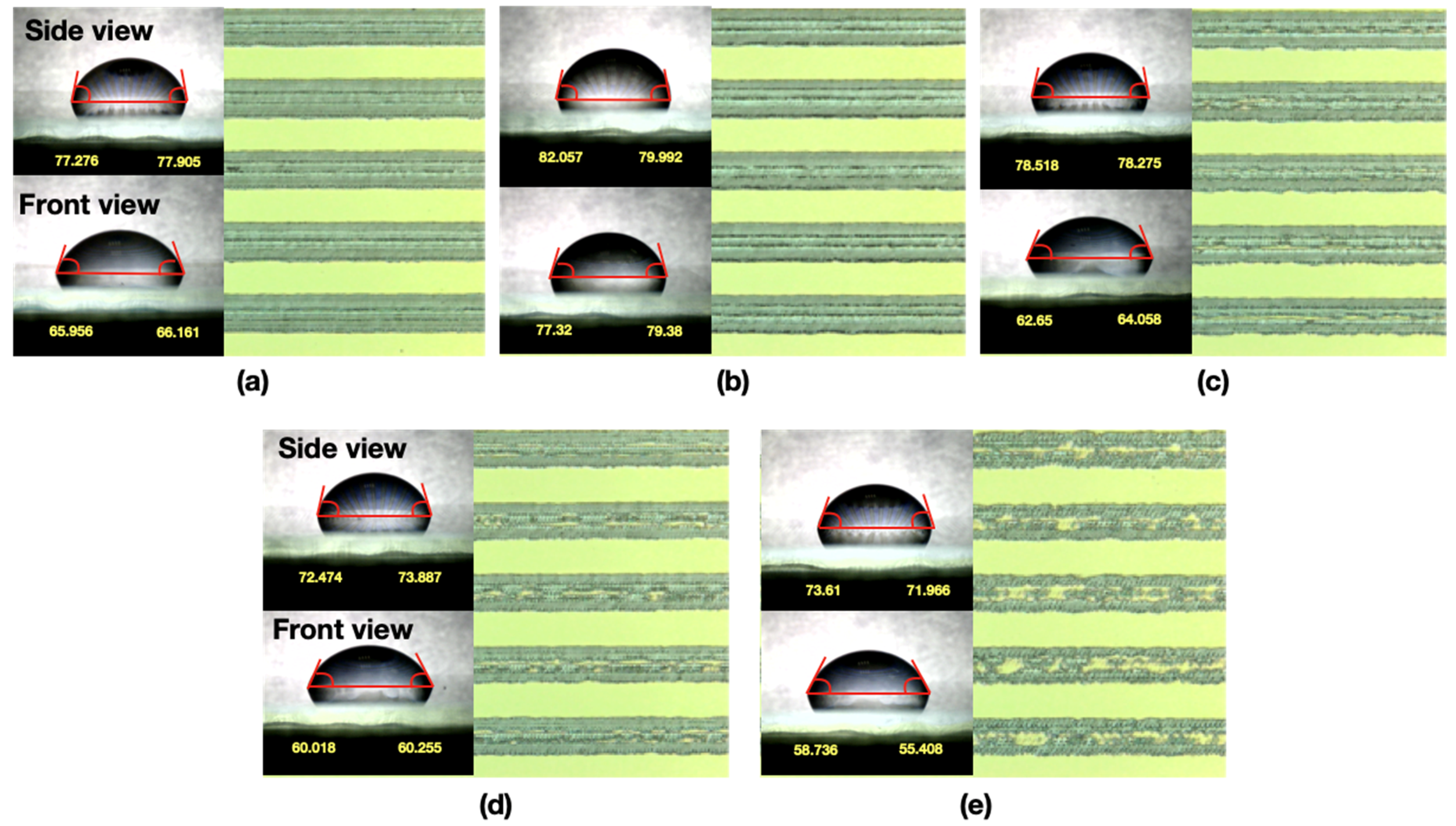
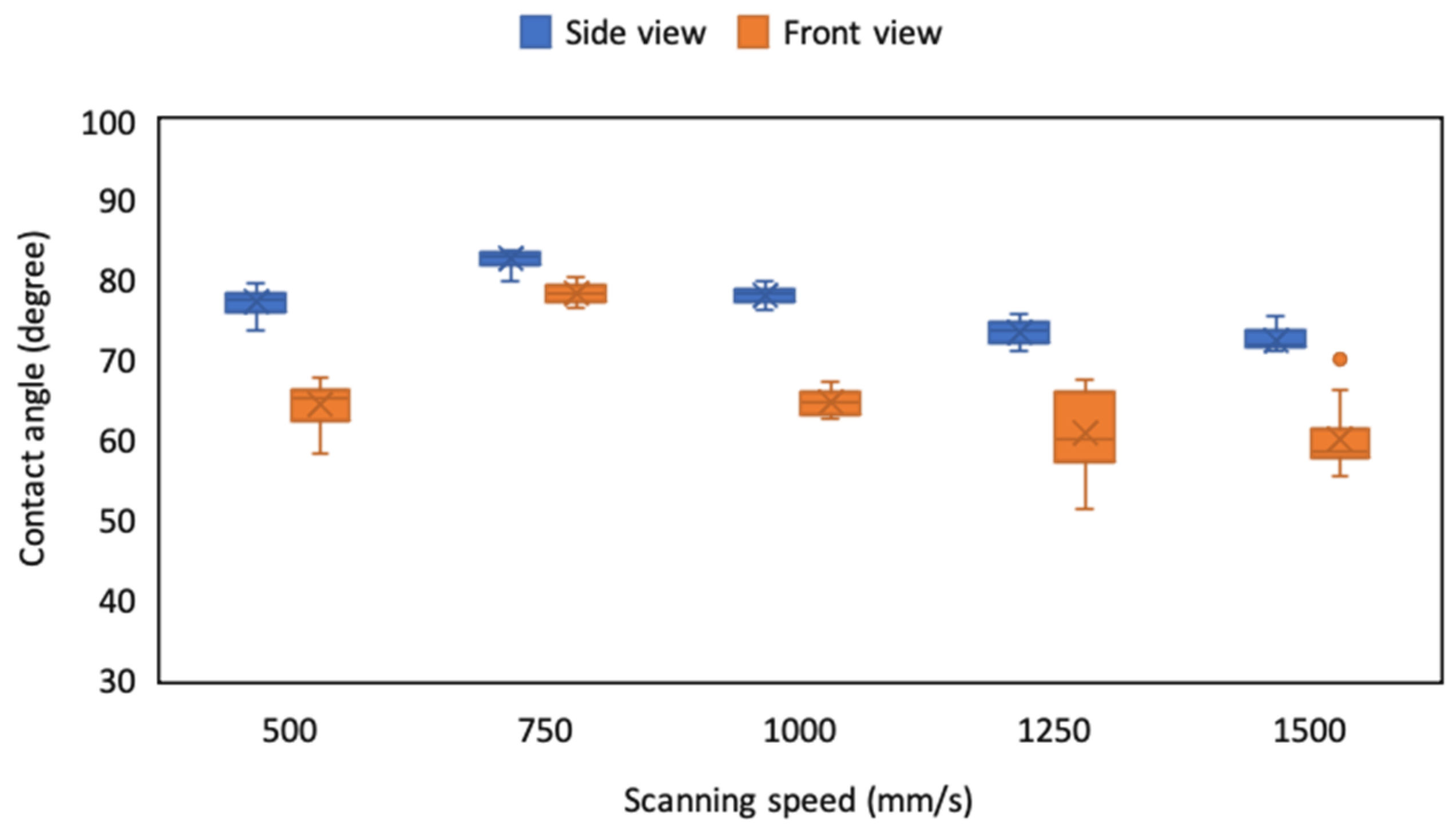

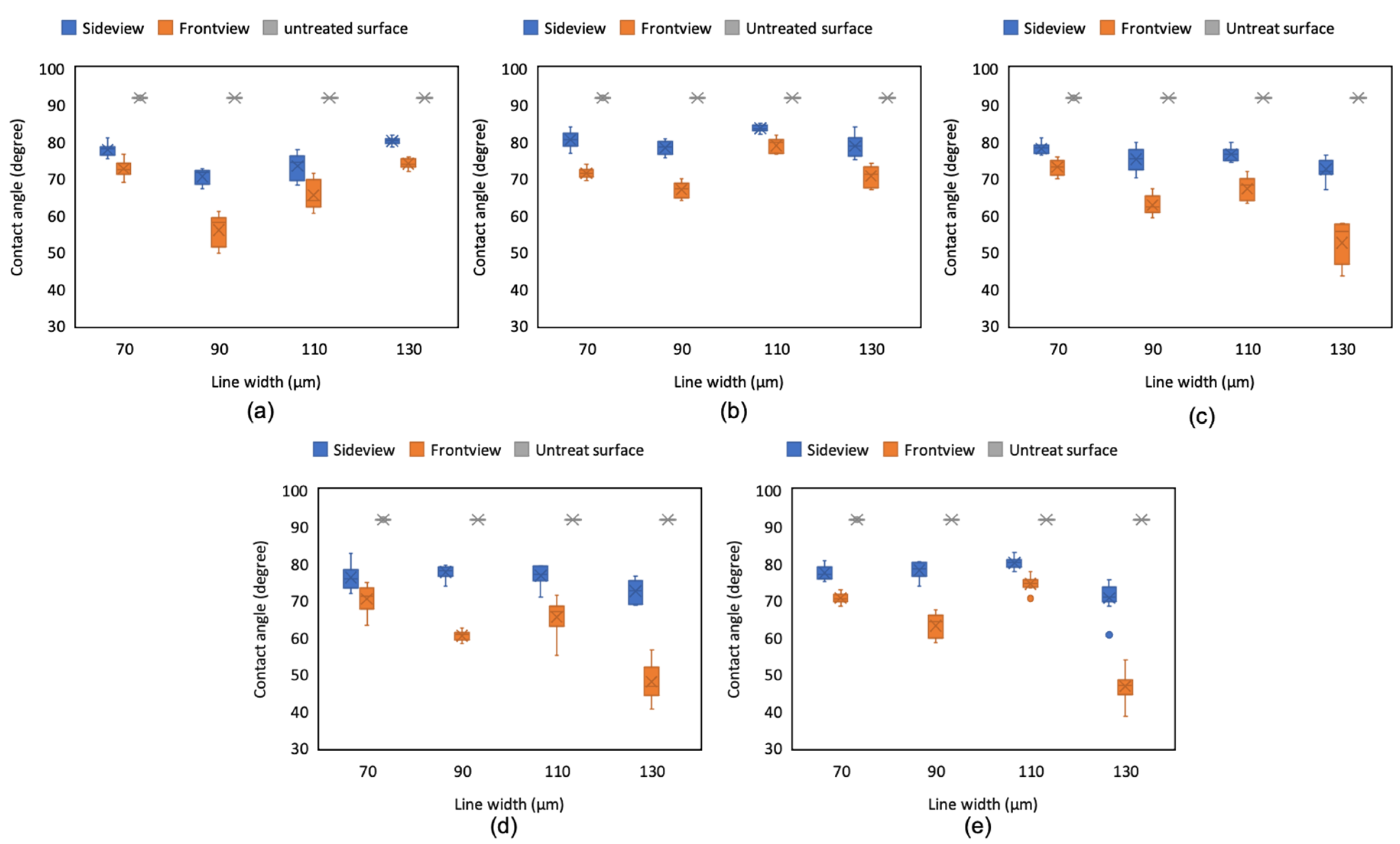
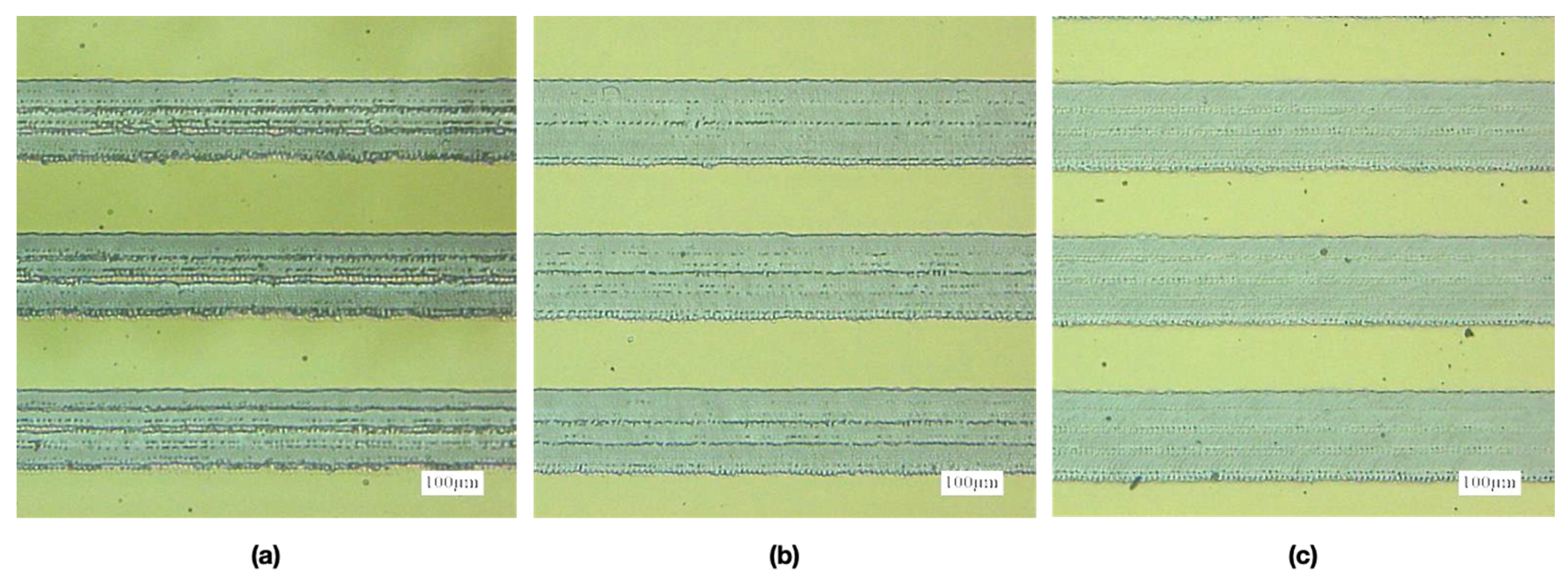
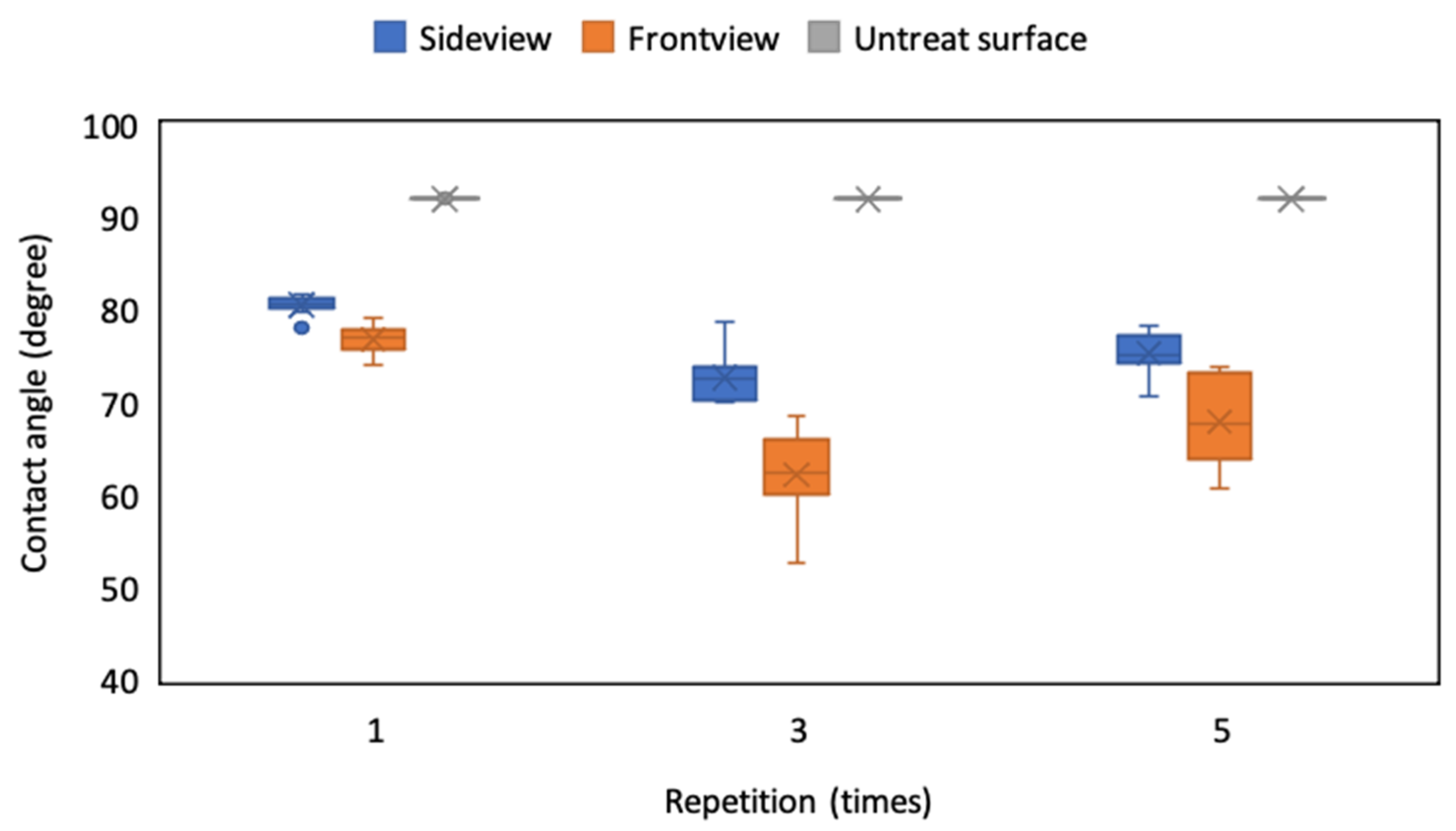
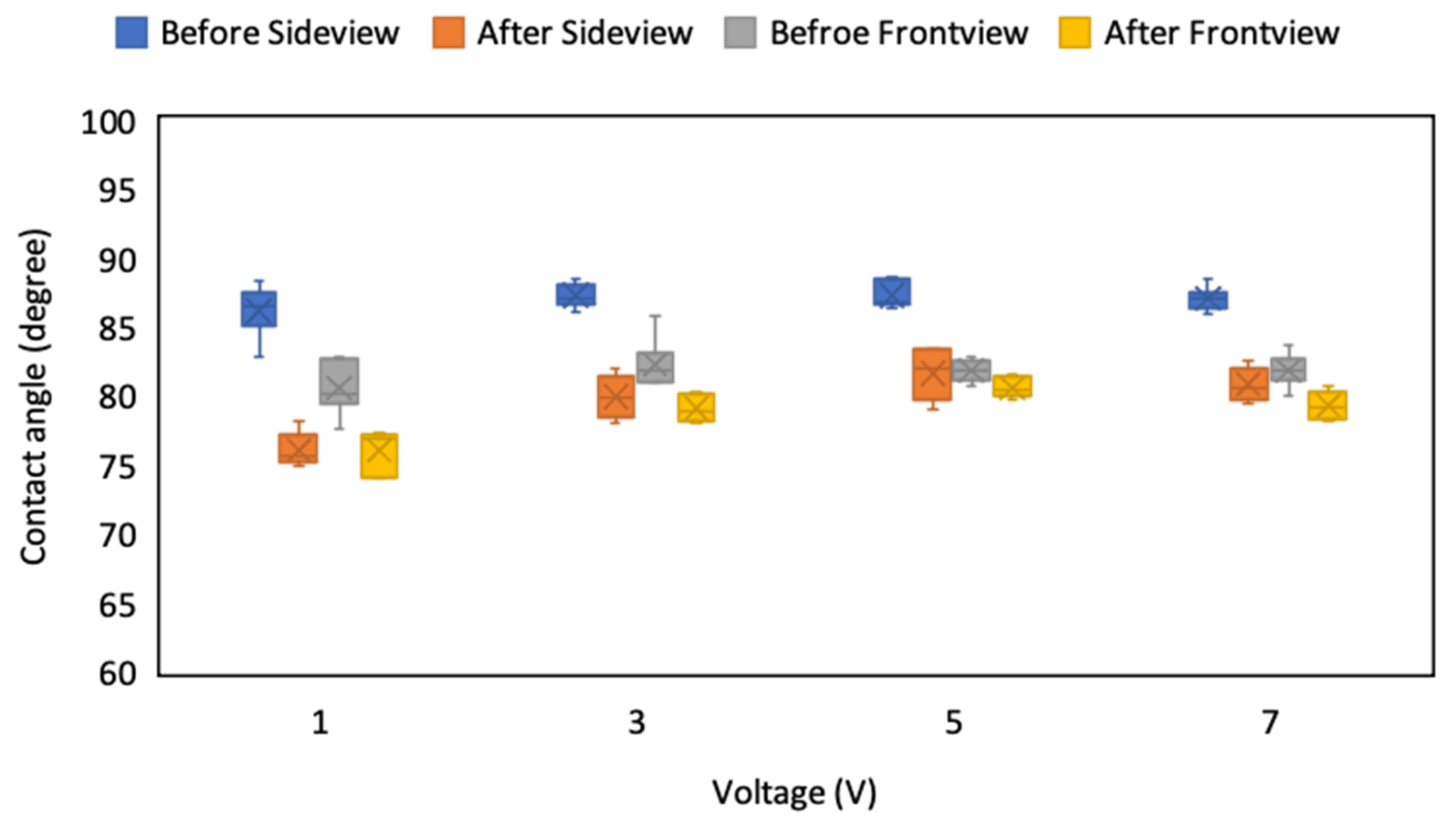
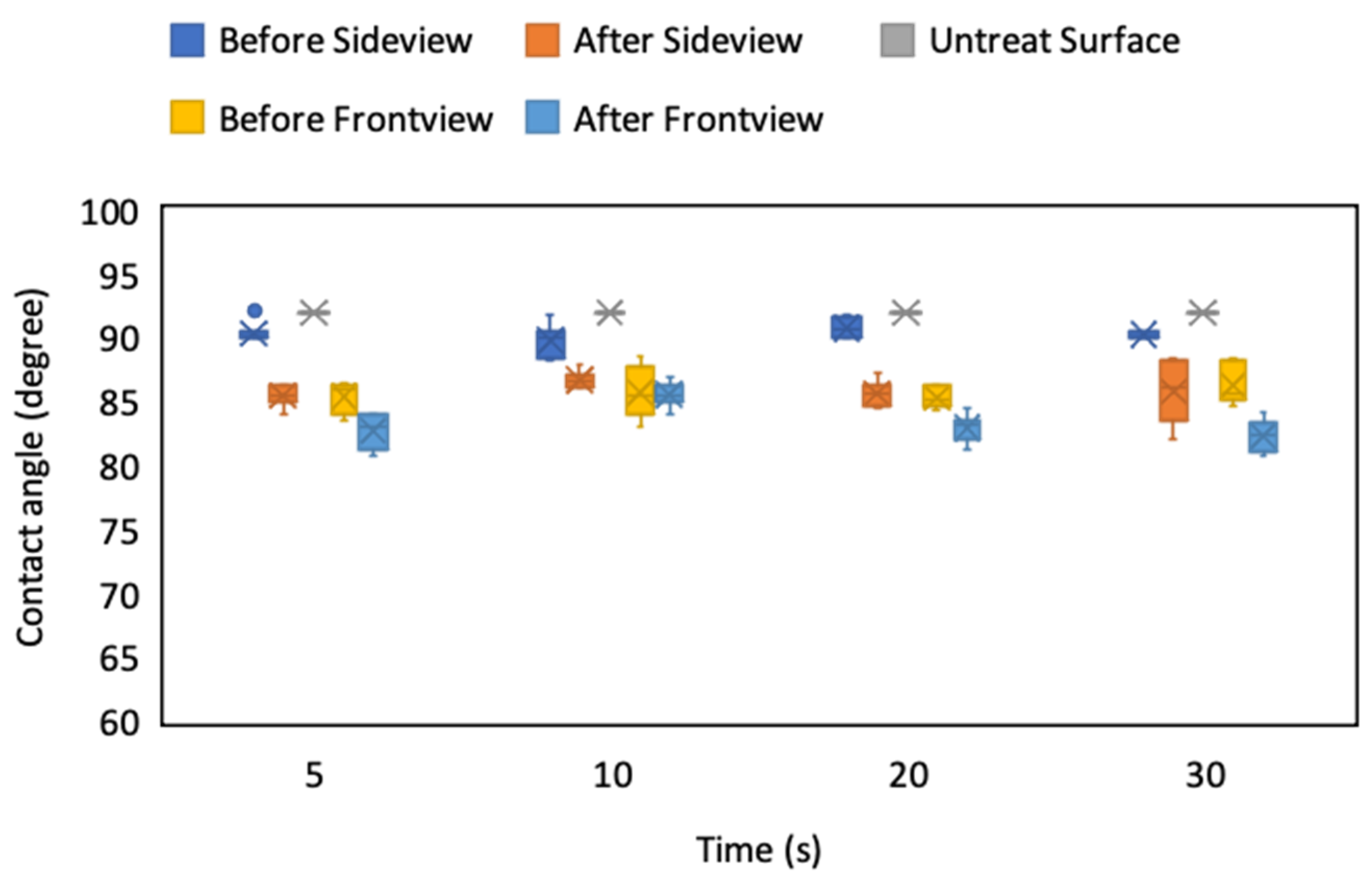
| Scanning Speed (mm/s) | 500 | 750 | 1000 | 1250 | 1500 |
|---|---|---|---|---|---|
| Ra (μm) | 0.292 | 0.290 | 0.453 | 0.493 | 0.573 |
| Rq (μm) | 0.399 | 0.411 | 0.619 | 0.652 | 0.741 |
| Line Width and Pitch (μm) | 70 | 90 | 110 | 130 |
|---|---|---|---|---|
| Sa (μm) | 0.635 | 0.632 | 0.518 | 0.679 |
| Sq (μm) | 0.793 | 0.788 | 0.660 | 0.846 |
Publisher’s Note: MDPI stays neutral with regard to jurisdictional claims in published maps and institutional affiliations. |
© 2021 by the authors. Licensee MDPI, Basel, Switzerland. This article is an open access article distributed under the terms and conditions of the Creative Commons Attribution (CC BY) license (http://creativecommons.org/licenses/by/4.0/).
Share and Cite
Tsai, H.-Y.; Hsu, C.-N.; Li, C.-R.; Lin, Y.-H.; Hsiao, W.-T.; Huang, K.-C.; Yeh, J.A. Surface Wettability and Electrical Resistance Analysis of Droplets on Indium-Tin-Oxide Glass Fabricated Using an Ultraviolet Laser System. Micromachines 2021, 12, 44. https://doi.org/10.3390/mi12010044
Tsai H-Y, Hsu C-N, Li C-R, Lin Y-H, Hsiao W-T, Huang K-C, Yeh JA. Surface Wettability and Electrical Resistance Analysis of Droplets on Indium-Tin-Oxide Glass Fabricated Using an Ultraviolet Laser System. Micromachines. 2021; 12(1):44. https://doi.org/10.3390/mi12010044
Chicago/Turabian StyleTsai, Hsin-Yi, Chih-Ning Hsu, Cheng-Ru Li, Yu-Hsuan Lin, Wen-Tse Hsiao, Kuo-Cheng Huang, and J. Andrew Yeh. 2021. "Surface Wettability and Electrical Resistance Analysis of Droplets on Indium-Tin-Oxide Glass Fabricated Using an Ultraviolet Laser System" Micromachines 12, no. 1: 44. https://doi.org/10.3390/mi12010044
APA StyleTsai, H.-Y., Hsu, C.-N., Li, C.-R., Lin, Y.-H., Hsiao, W.-T., Huang, K.-C., & Yeh, J. A. (2021). Surface Wettability and Electrical Resistance Analysis of Droplets on Indium-Tin-Oxide Glass Fabricated Using an Ultraviolet Laser System. Micromachines, 12(1), 44. https://doi.org/10.3390/mi12010044






